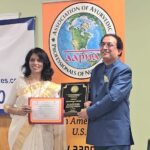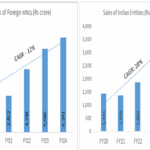Round Table Expert Zoom Meeting on Lessons learnt from COVID-19
India
healthysoch
New Delhi, May 28, 2020 :
Participants: Dr KK Aggarwal, Dr Alok Roy, Dr AK Agarwal, Dr Narottam Puri, Dr Suneela Garg, Dr Girdhar Gyani, Dr Atul Pandey, Dr Ashok Gupta, Dr Jayakrishnan Alapet, Dr Alex Thomas, Dr K Kalra, Dr (Major) Prachi Garg, Ms Ira Gupta, Dr Sanchita Sharma
- Do not miss the first case in the country or your state. A first case of a new disease is a potential epidemic.
- We should have permanent Arogya Setu App for all notifiable communicable diseases, specifically MDR TB and other highly infectious diseases. Personal privacy does not apply in cases of notifiable diseases. The concept of “broader good” comes into play here.
- Elderly are at risk. We must have a national program for the protection of health of the elderly. There is a need to set up separate geriatric medicine departments in all medical colleges. It is also important to establish a group of doctors aged ≥65 years. Their rich experience can be tapped in times of crisis.
- Contact time: We must know the contact time for every disease. For TB, the contact time is 8 hours. For COVID-19, the contact time is between 10 and 30 minutes. A casual contact time of less than 10 minutes has low risk of transmission (monitoring). If the contact time is more than 30 minutes, the risk of transmission is high (quarantine).
- A virus may have several different types of presentations/manifestations in different countries or population groups and the treatment will be according to the presentation. Identify the presentation in different communities. COVID-19 has so far shown the following 7 characteristics:
- It is a viral illness, so it is a self-limiting disease; antiviral drugs like remdesivir may work.
- It has bacterial activity as in some cases, procalcitonin is high, neutrophilia is also seen; antibiotics like doxycycline, azithromycin may work.
- It has some HIV-like properties, as there is lymphopenia (viruses usually cause lymphocytosis), decrease in CD4 cell count; anti-HIV drugs may be effective.
- It causes immuno-inflammation: Viruses do not cause immune-inflammation. But, increase in ESR (>100), CRP, ferritin (acute phase reactants) is seen in COVID-19. Hydroxychloroquine may be effective. Immuno-inflammation is being seen much more in European countries than in Asian countries.
- It causes thrombo-inflammation: Increase in D-dimer and fibrinogen (usually if D-dimer is high, fibrinogen is low); anticoagulation may be important.
- Silent hypoxia (walking dead phenomenon): Patients have low oxygen but are conscious. Usually, people with hypoxia are drowsy, irritable.
- Cytokine storm: ARDS
- We have learnt three terms: Home isolation, home quarantine and monitoring.
- The pandemic has focused on different populations, e.g. migrants, factory workers, private sector
- The problem of migrants should be anticipated timely and planned properly. Positivity rate in India is 3.5-7%.
- Random testing rate of people reaching Bihar is 8% and for those reaching UP is 5%.
- Living with fear: Manage fear by being well-prepared.
- Treat the patient, not the report. About 30% of tests may be false-negative.
- There should be a worldwide ban on wet markets.
- Vaccine may or may not come. We may be over-relying on a vaccine.
- Health infrastructure will change. Now, new hospitals will be airy, roomier, more ventilated; there will be no central AC, no attached bathroom with every room.
- Standard precautions: We did not learn social distancing from the 2009 H1N1 flu. Face to face meeting is more risky than side to side meeting.
- Never ignore nature.
- Never ignore essential health services.
- Super spreader: A latest study from Israel says that 5% people are responsible for the remaining 95% of transmission. This is similar to the 80/20 rule, which has been the standard teaching in PSM, where approximately 20% of infected individuals are responsible for 80% of transmissions. The first known super spreader was in South Korea (patient #31) and then there have been super spreaders in different countries.
- We have learnt how to sustain the improved pollution. If pollution levels are very high, then a lockdown of 1-2 days may help.
- Terms like R0 (R naught; reproduction number), herd immunity have been revisited.
- Create more awareness in the society.
- Transparent communication and dissemination of accurate information to promote community engagement is important to allay the fears, stigma. We need to be consistent in data projections.
- “Be a realist rather than being an optimist when presenting data”
- This pandemic has highlighted the inadequacy in testing and testing facilities, the importance of investment in health and more focus on research and indigenous health technologies.
- We must keep a watch on every situation happening in the world. Be prepared in advance.
- The disease has focused on the need of Epidemic Intelligence services, which can forecast epidemics. A training program can be started on pilot basis in few medical colleges.
- Learn to live with Corona is the new buzzword.
- A change in lifestyle with new norms is key “self-disciplined”; practice social distancing, personal hygiene.
- This is an opportunity to be self-sufficient, self-reliant and promote “Make in India”. The pandemic started with virtually no PPE but there are now over 600 manufacturers.
- We have to devise ways to keep the economy running as the pandemic has greatly affected the jobs leading to a negative GDP.
- This is an opportunity to decongest slums.
- We need to have a White Paper on national health security.
Histopathology :
Seven lungs from patients who died of confirmed COVID-19 and seven lungs obtained during autopsy from patients who died from H1N1 ARDS in 2009, revealed three distinctive features of COVID-19:
- Severe endothelial injuryassociated with intracellular SARS-CoV-2 virus and disruption of endothelial cell membranes
- Extensive vascular thrombosis with microangiopathy and occlusion of alveolar capillaries
- Significant new vessel growth through intussusceptive angiogenesis.
This is a respiratory virus that causes a vascular disease, and damage to the blood vessels.
[May 21 in the New England Journal of Medicine.]
Although lungs from influenza sufferers also had diffuse alveolar damage, the COVID-19 lungs had 9-fold as many segments occluded by microthrombi (P < .001).
Tissue hypoxia was common in the lungs from both these groups of patients, the greater degree of endothelialitis and thrombosis in the lungs from patients with COVID-19 possibly contributes to the relative frequency of sprouting and intussusceptive angiogenesis in these patients.
The amount of angiogenesis seen was unexpected, and nearly 2.7-times higher than that seen in lungs from patients with influenza (P < .001).
Wuhan Update :
In two weeks, the health authorities in China have administered 6.5 million tests for the coronavirus in Wuhan, the city of origin of the pandemic, where six new infections detected two weeks ago raised concerns of a second wave of contagion. Two hundred cases were found, mostly people who showed no symptoms.
Author : Dr KK Aggarwal , President CMAAO, HCFI, Past National President IMA, Chief Editor Medtalks
healthysoch







